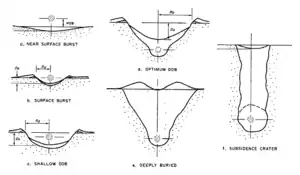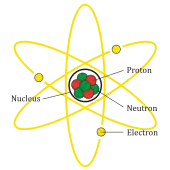Chagai-II
Chagai-II is the codename assigned to the second atomic test conducted by Pakistan, carried out on 30 May 1998 in the Kharan Desert in Balochistan Province of Pakistan.[3] Chagai-II took place two days after Pakistan's first successful test, Chagai-I, which was carried out on 28 May 1998 in the Ras Koh area in Chagai District, Balochistan, Pakistan.
| Chagai-II | |
|---|---|
| Information | |
| Country | Pakistan |
| Test site | Kharan Desert |
| Period | 30 May 1998 |
| Number of tests | 1 |
| Test type | Underground tests |
| Device type | Fission |
| Max. yield | 25 kilotons of TNT (100 TJ)[1][2] |
| Test chronology | |
The initial goals were to test the new designs of the weapon rather than studying the effects, and were different from the first tests in that they were primarily conducted by the Pakistan Atomic Energy Commission (PAEC), with the Pakistan Armed Forces engineering formations having only a supporting role.[4]
The tests detonated implosion-type boosted-fission military-grade plutonium devices, contrary to the Chagai-I tests that were weapons-grade uranium devices.[4] The performance of these tests made it a total of six tests performed by Pakistan in May 1998.[4]
Test preparations
Selection and planning
The Kharan Desert is a sandy and mountainous desert, with very high temperatures.[5] The region is characterised by very low rainfall, high summer temperature, high velocity winds, poor soils, very sparse vegetation and a low diversity of plant species; its average temperature are recorded 55 °C (131 °F) in summer and 2.5 °C (36.5 °F) in winter session (sources vary).[3][6][7][8]
Safety and security required an isolated, remote, and inhabitant area with extreme weather conditions to prevent any possible Radioactive Fallout.[9] For this purpose, a three-dimensional survey was commenced by nuclear physicist Dr. Ishfaq Ahmad assisted by seismologist Dr. Ahsan Mubarak; it received final approval from Munir Ahmad in 1976.[10] Unlike the granite mountains, the PAEC requirement was to find a suitable site in a desert region with almost no wildlife to prevent any kind of mutation, and to study blast effects of the weapons.[11]
The weapon-testing sites were suspected to be located at Kharan, in a desert valley between the Ras Koh region to the north and Siahan Range to the south.[12] Subsequently, the Chagai-Ras Koh-Kharan were cordoned off, becoming restricted entry zones closed to the public.[12]

After PAEC officials clearing with Prime minister Zulfikar Ali Bhutto, the preparations and logistics matters were given to the Pakistan Armed Forces.[10] A secretly coded telegram was sent from the Prime Minister's Secretariat to V Corps Brigadier Muhammad Sarfraz.[10] A helicopter, was arranged for the civilian scientists by Sarfraz.[10] In 1977, Sarfraz was dispatched to the Military Engineering Service to commission engineering formations of the Pakistan military by General Zia-ul-Haq, the Chief of Army Staff.[10] The PAEC officials readily agreed that the secondary tests would be scientific in nature with the armed forces playing the engineering roles.[10]
The Special Development Works (SDW), assisted by the Corps of Engineers, Pakistan Army Corps of Electrical and Mechanical Engineering (PEME), and Frontier Works Organisation (FWO), spearheaded the engineering of the potential sites.[14] The military engineers were well aware of satellite detection, therefore the site at Kharan was constructed with extra cautions.[15] The SDW built around 24 cold test sites, 46 short tunnels, and 35 underground accommodations for troops and command, control and monitoring facilities.[16] The test site was 300 by 200 feet (91 by 61 m) and was L-shaped horizontal shafts.[17] Extensive installations of diagnostic cables, motion sensors, and monitoring stations were established inside the test site.[18] It took nearly 2–3 years for the SDW to prepare and preparations were completed in 1980, before Pakistan acquired the capability to physically develop an atomic bomb.[10]
After posting at the General Headquarters, Sarfraz transferred the work to Lieutenant-General Zahid Ali Akbar, the Engineer-in-Chief of the Pakistan Army Corps of Engineers.[19] The modernisation of the tests labs were undertaken by the FWO; the FWO uncredited work in the construction of the weapon-testings labs in Kharan Desert, and had supervised the entire construction on the sites along with the SDW.[20]
Final preparations were overseen by then-Lieutenant-Colonel Zulfikar Ali Khan and PAEC chairman Munir Ahmad, assisted by Dr. Ishfaq Ahmad, the Member (Technical) of PAEC.[12]
Test and blast yields
The Pakistan Atomic Energy Commission (PAEC) teams of scientists and engineers arrived at the site led by Dr. Samar Mubarakmand, a nuclear physicist.[12] The tests were conducted on 30 May 1998 at 13:10 hrs (1:10 pm) (PKT).[12] The atomic bomb was small in size but very efficient and produced a very powerful shock wave and blast yield.[4][21][22]
The devices were boosted fission weapons using military-grade plutonium, yielding 60.1% of the first tests performed two days earlier.[4] The Theoretical Physics Group (TPG) calculated that the blast yield was 20 kt of TNT equivalent.[12] Although the American Physical Society estimated the yield at 8 kilotons of TNT (33 TJ) based on data received by their computer,[2][23][24] Dr. Abdul Qadeer Khan confirmed the TPG blast calculations in an interview in 1998.[1][25]
A crater now takes the place of what used to be a small hillock in the rolling desert, marking the ground zero of the nuclear test.[10] The Pakistan Atomic Energy Commission (or PAEC) had tested one or more plutonium nuclear devices, and the results and data of the devices were successful as was expected by the Pakistan's mathematicians and seismologists.[10][26]
Test teams
Pakistan Atomic Energy Commission
- Samar Mubarakmand, Member (Technical) at PAEC.
- Hafeez Qureshi, Directorate of Technical Development (DTD)
- Irfan Burney, Director of Directorate of Technical Procurement (DTP).
- Tariq Salija, Director of the Radiation and Isotope Applications Division (RIAD).
- Muhammad Jameel, Director of Directorate of Science and Engineering Services (DSES)
- Muhammad Arshad, the Chief Scientific Officer (CSO).
- Asghar Qadir, director, Theoretical Physics Group
Pakistan Army Corps of Engineers
- Lieutenant General Zulfikar Ali Khan Engineer-in-Chief of the System and Combat Engineering Division of the Pakistan Army Corps of Engineers
See also
References
- Khan (2012, pp. 200–202)
- Reed (2009, p. 258)
- Planning & Development Department Government of Balochistan, Quetta (18 July 2011). "District Development Profile 2011: Kharan" (PDF). balochistan.gov.pk/. Archived from the original (PDF) on 2014-09-13. Retrieved 2015-06-10.
- Mir, Hamid. "Interview with Samar Mubarakmand". pakdef.org/. PakDef, original aired on GEO TV in 2005. Archived from the original on 2019-09-19. Retrieved 2015-06-11.
- FAS. "Kharan Desert". fas.org/. Federation of American Scientists. Retrieved 2015-06-10.
- "Kharan documentary". Kharan documentary. 26 January 2014. Retrieved 2015-06-10.
- Pakistan 360. "Kharan Desert". pakistan360degrees.com/. Pakistan 360. Archived from the original on 2020-01-06. Retrieved 2015-06-10.
- Mares, Michael A. (1999). Encyclopedia of Deserts. University of Oklahoma Press. pp. 301–302. ISBN 978-0-8061-3146-7.
- Shahid-ur-Rehman (1999, pp. 20–21)
- Azam, Rai Muhammad Saleh (June 2000). "When Mountains Move". Rai Muhammad Saleh Azam. Karachi, Pakistan: The Nation (1999) and Defence Journal (2000). p. 1. Retrieved 2012-05-08.
- Khan (2012, pp. 280–282)
- Sublette, Carey (2 January 2002). "Historical Background: §Preparing to Build the Bomb". Nuclear Weapon Archive. Retrieved 2011-11-11.
- PAEC Govt. "The Weapon-Testing Laboratories: An illustration by PAEC". Government of Pakistan release. Retrieved 2012-09-07.
- Khan (2012, pp. 183–184)
- Shahid-ur-Rehman (1999, pp. 25)
- Khan (2012, pp. 184)
- Shahid-ur-Rehman (1999, pp. 24–25)
- Shahid-ur-Rehman (1999, pp. 26–27)
- Shahid-ur-Rehman (1999, §The nuclear development under Army: General Zahid Ali)
- Shahid-ur-Rehman (1999, pp. 28–30)
- Shahid-ur-Rehman (1999, pp. 30–31)
- Khan (2012, pp. 185–186)
- Reed (2009, pp. 250–255)
- Albright, David (2004). "The shots heard 'round the world". Bulletin of the Atomic Scientists. Educational Foundation for Nuclear Science, Inc.: 22–25. ISSN 0096-3402. Retrieved 2015-01-01.
- Khan, Kamran (30 May 1998). "Interview with Abdul Qadeer Khan". The News International. Islamabad. p. 1. Retrieved 2015-06-14 – via nuclearweaponarchive.org.
- "Nuclear Tests:§The Plutonium Device". Federation of American Scientists (FAS) and Pakistan Atomic Scientists Foundation (PASF). 11 December 2002. Retrieved 2011-11-11.
- Khan, Feroz Hassan (2012). Eating Grass: The Making of the Pakistan Atomic Bomb. Palo Alto, CA: Stanford University Press. ISBN 978-0804784801.
- Reed, Thomas Binnington (2009). The Nuclear Express: A Political History of the Bomb and Its Proliferation. Zenith Press. ISBN 978-0760335024.
- Shahid-ur-Rehman (1999). Long Road to Chagai. Islamabad: Printwise Publications. ISBN 9789698500009.
External links
- Chaghi-II Test on YouTube
- "Comparison of India's and Pakinstan's nuclear tests and the 30 May 1998 Afghanistan earthquake". Broadband Seismic Data Collection Center. Broadband Seismic Data Collection Center, Pakistan Atomic Scientist Federation (PASF), Pakistan Nuclear Society, Pakistan Seismic Department (PAEC), and Pakistan Meteorological Department. 23 November 2010. Archived from the original (php) on 2012-03-21. Retrieved 2011-11-11.
- "KNET recording of second Pakistani nuclear test waveforms". Broadband Seismic Data Collection Center. Broadband Seismic Data Collection Center, Pakistan Atomic Scientist Federation (PASF), Pakistan Nuclear Society, Pakistan Seismic Department (PAEC), and Pakistan Meteorological Department. 23 November 2010. Archived from the original (php) on 2012-03-21. Retrieved 2011-11-11.
